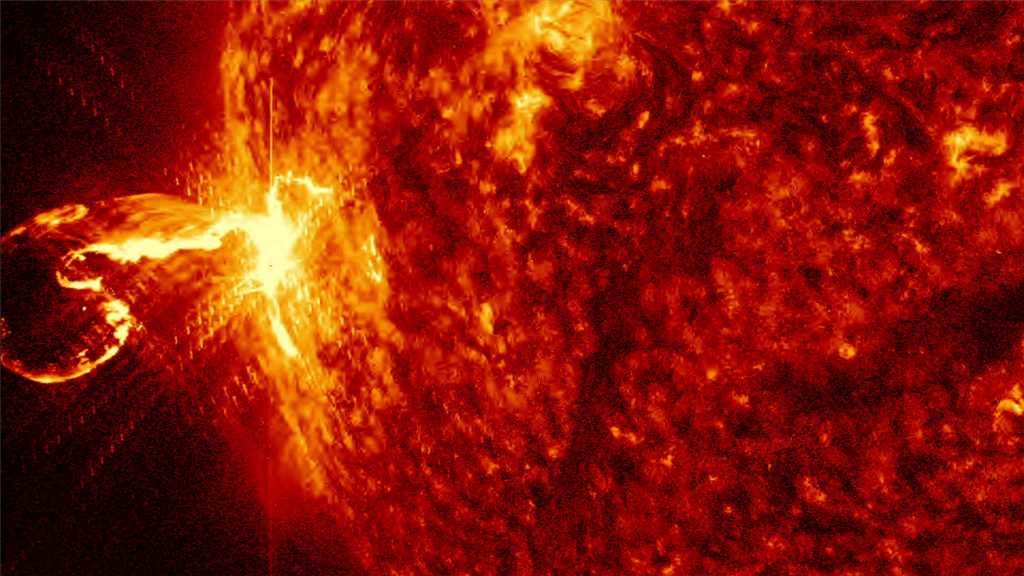
Earth ‘attacked’ by the Sun

Solar storm creates techno chaos and climate change
- Dateline
- 13 December 2013
Welcome to Blackout Friday. Yes, it’s Friday the 13th. You probably won’t be able to read this on your flexipad until systems are restored next week, when the cosmic storm has abated.
In the biggest event of its kind in recent history, the Sun sent a massive solar flare arcing toward Earth, as if aiming at the heart of our technological hubris. The geomagnetic storm that accompanied it knocked out communications systems across the globe, despite engineers being forewarned of the risk.
The truth is, our hi-tech lifestyles and economies just can’t function without the networks, satellites and ‘smart’ systems we’ve built in the past 50 years. Even a temporary shut down just wasn’t an option. Disaster recovery operations are in full swing, but the scale and extent of the disruption has surprised most scenario planners.
Air travel is limited to visual flight rules as the world has turned into a gigantic Bermuda Triangle. GPS is off-line. Ships’ navigators are resorting to sextants and mechanical clocks while they wait for the silent skies to come back to life.
“If a second flare takes out our backup systems, then we are really in trouble,” was the opinion of one network engineer, who preferred to remain anonymous. “NASA is not sure that the storm is over. Timing is crucial.”
Economists are already speculating that the damage to business and trade outweighs the worst natural disasters of the previous decade put together, including Hurricane Katrina and the Icelandic volcano eruptions. Climate scientists are also worried, as cosmic radiation affects high cloud formation.
Even fibre-optic repeaters have been knocked out. I’ll have to use a carrier pigeon to send this story!
ANALYSIS >> SYNTHESIS: How this scenario came to be
Protection from the Sun
The Sun is not a stable source of energy. It follows a fairly regular cycle of activity, reaching peaks every 11 years. During quiet phases, there are virtually no sunspots. During solar maxima, many sunspots occur and huge flares are ejected from the surface. What is difficult to predict is the intensity of these active phases. The next peak of activity will be in the 2012-2013 time-frame. Mausumi Dikpati of the National Center for Atmospheric Research thinks it’s going to be big. “The next sunspot cycle will be 30% to 50% stronger than the previous one,” she says. If correct, the years ahead could produce a burst of solar activity second only to the historic Solar Max of 1958.
Solar flares propel massive bursts of magnetic energy deep into space, engulfing the Earth in a cosmic storm. This electromagnetic stream disrupts communication satellites and radio devices like mobile phones, as well as electrical equipment. Ultra-high-voltage transformers, of which the United States is the largest user globally, are particularly sensitive to large geomagnetic surges at the Earth’s surface.
Without these massive transformers the national power grid goes down, and they can take up to a year to repair or replace. So perhaps the Mayan astronomers were not far off the mark, when they predicted a global catastrophe toward the end of 2012. If the next solar maximum is of unprecedented strength, and circumstances conspire to direct the energy straight at our planet, we could face communications and power blackouts that last for months, even years in places.
Never before have we been so dependent on electrically powered, digital communication systems. Everything from travel and logistics to financial transactions and emergency services are acutely coupled to global communications and control systems. An extended blackout could seem like the end of the world, to some.
Much of the damage can be minimized if we know in advance that the storm is approaching, but at substantial cost. Putting satellites in a dormant state and disconnecting transformers can protect them from damaging electrical surges. But that alone would disrupt the economies of the world, especially if the scare proves to be unfounded. NASA’s main satellite watching the Sun can only give about 15 minutes warning of a space storm that will reach the Earth. Is that enough to prevent disaster?
Links to related stories
- Massive solar flare 'could paralyse Earth in 2013' - Daily Mail, 21 September 2010
- Solar Storm Warning - Nasa, 10 March 2006
- The 2012 Apocalypse — And How to Stop It - Wired News, 17 April 2009
- Scientists Issue Unprecedented Forecast of Next Sunspot Cycle - NCAR news release, 6 March 2006
- MindBullet: A WORLD WITHOUT JETS (Dateline: 1 January 2023, Published: 13 May 2010)
Warning: Hazardous thinking at work
Despite appearances to the contrary, Futureworld cannot and does not predict the future. Our Mindbullets scenarios are fictitious and designed purely to explore possible futures, challenge and stimulate strategic thinking. Use these at your own risk. Any reference to actual people, entities or events is entirely allegorical. Copyright Futureworld International Limited. Reproduction or distribution permitted only with recognition of Copyright and the inclusion of this disclaimer.